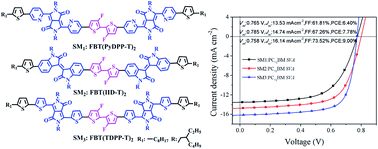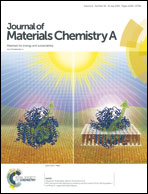Efficient chemical structure and device engineering for achieving difluorinated 2,2′-bithiophene-based small molecular organic solar cells with 9.0% efficiency†
Abstract
Linear small molecules have been proved to be promising donor materials for high performance small molecular solar cells (SMSCs). In this paper, a series of narrow-band gap, π-conjugated small molecules (SMs) with a D(A–Ar)2 linear framework, denoted as FBT(PyDPP-T)2, FBT(IID-T)2 and FBT(TDPP-T)2, based on fluorinated 2,2′-bithiophene (FBT) as an electron-donating (D) central core, pyridine-flanked diketopyrrolopyrrole (PyDPP), isoindigo (IID) or thiophene-flanked diketopyrrolopyrrole (TDPP) as electron-accepting (A) units, and 2-octylthiophene (Ar) units as end-capping units, have been designed and synthesized for application as donor materials in solution-processed SM organic solar cells (OSCs). The impacts of different acceptor units and fluorinated central cores on bulk properties, such as the optoelectronic properties, carrier mobility, the HOMO/LUMO energy level, and the morphologies of blend films, as well as optimization on device performance via appropriate solvent vapor annealing (SVA) are systematically investigated. The as-cast devices based on FBT(PyDPP-T)2, FBT(IID-T)2 and FBT(TDPP-T)2 exhibit PCEs of 5.04%, 5.68% and 6.86%, respectively. Encouragingly, after a SVA treatment with carbon disulfide (CS2) for 20 s, an impressively improved power conversion efficiency (PCE) from 6.86% to 9.00% with an increase of 35% was obtained in the FBT(TDPP-T)2/PC71BM (w/w, 1 : 1) based cells due to an enhanced short circuit current density (Jsc) of 16.14 mA cm−2 and fill factor (FF) of 73.52%, which is among the highest reported for D(A–Ar)2-type SM-based solar cells with a PCE up to 9.0% so far. Our research results reported here clearly demonstrate that highly efficient SM-OSCs can be obtained via rational design of their molecular structure and optimization of the phase-separated morphology through an appropriate solvent-vapor annealing process.



 Please wait while we load your content...
Please wait while we load your content...